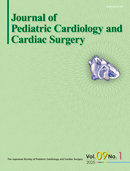最新号
選択された号の論文の7件中1~7を表示しています
- |<
- <
- 1
- >
- >|
Review
-
2025 年9 巻1 号 p. 1-9
発行日: 2025/01/31
公開日: 2025/10/21
[早期公開] 公開日: 2024/12/17PDF形式でダウンロード (384K)
Original Article
-
2025 年9 巻1 号 p. 10-22
発行日: 2025/01/31
公開日: 2025/10/21
[早期公開] 公開日: 2025/01/17PDF形式でダウンロード (139K)
Case Report
-
2025 年9 巻1 号 p. 25-30
発行日: 2025/01/31
公開日: 2025/10/21
[早期公開] 公開日: 2024/12/24PDF形式でダウンロード (2054K) -
2025 年9 巻1 号 p. 31-34
発行日: 2025/01/31
公開日: 2025/10/21
[早期公開] 公開日: 2024/12/25PDF形式でダウンロード (2052K) -
2025 年9 巻1 号 p. 35-39
発行日: 2025/01/31
公開日: 2025/10/21
[早期公開] 公開日: 2024/12/19PDF形式でダウンロード (3388K)
Editorial Comment
-
2025 年9 巻1 号 p. 23-24
発行日: 2025/01/31
公開日: 2025/10/21
PDF形式でダウンロード (50K)
Guideline
-
2025 年9 巻1 号 p. 41-118
発行日: 2025/01/31
公開日: 2025/10/21
PDF形式でダウンロード (82610K)
- |<
- <
- 1
- >
- >|
